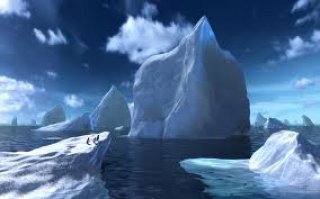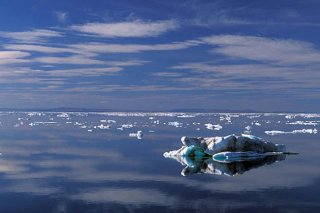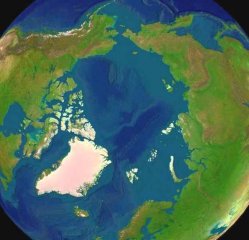
The Arctic is warming up faster than any other region. Because it plays a vital role in cooling the rest of the globe, the effects of this warming will be felt worldwide, not just on remote tundra.
Nineteenth-century explorer Fridtjof Nansen called the Arctic “nature’s great ice temple,” a place teeming with roaming polar bears and a forbidding landscape frozen since “the earliest dawn of time.”
But today, one cannot venture far enough north to escape global warming. The region has heated up nearly twice as fast as the rest of the globe over the past 50 years, according to a 2004 study assessing climate change in the Arctic. Land-based ice such as glaciers, ice sheets and permafrost and floating ice are vanishing, and the ongoing thaw has profound ramifications for the rest of the world.
The Arctic is critical to the globe’s climate and influence temperatures everywhere. It sounds counter-intuitive, but the Arctic plays a primary role in distributing heat around the world through what is known as the “heat pump.” The ocean’s currents circulate heat throughout the world, through a system known as the “great conveyor belt.” Two main forces keep the conveyor moving: winds and ocean density differences. The Arctic is key to the density differences.
The conveyor belt’s critical points are where surface waters plunge into deep waters. This happens only in a few places, two of which are in the North Atlantic. As the ocean surface waters cool in the far north, they become denser and sink toward the bottom of the ocean. There, the cold water flows toward the equator. This combination of sinking and flow helps drive the ocean conveyor.
Because the cold waters that flow south must be replaced, warm surface currents flow farther north and deliver warmth to places far north. Without the ocean conveyor’s heat pump, Europe’s temperate climate would be much colder.
 Global warming is changing that key spot in the North Atlantic where the surface waters plunge. A mix of increased precipitation, river run-off and melting ice—all related to climate change—is making surface waters in the north less salty and dense, weakening this major pump in the ocean’s natural circulation.
Global warming is changing that key spot in the North Atlantic where the surface waters plunge. A mix of increased precipitation, river run-off and melting ice—all related to climate change—is making surface waters in the north less salty and dense, weakening this major pump in the ocean’s natural circulation.Also speeding up the Earth’s warming is the loss of Arctic ice. Like a mirror, ice bounces sunlight back toward space, preventing sunlight from heating the surface. Winds carry the cooler air down from Canada into the U.S., cooling our climate.Open water and bare soil are not as bright as ice and snow, so they absorb heat instead of reflecting it. When ice melts, the Earth’s darker surfaces are exposed and thus absorb more solar energy. This extra heat melts even more ice, which leads to even more dark surfaces and absorption. This is what scientists call a positive feedback loop. Once the loop gets going, it tends to keep going—and to speed up. Less ice means less cooling much faster. Or, as the American Meteorological Society’s senior scientist Susan Joy Hassol put it to U.S. senators in a committee hearing in 2004: “What we’re looking at is having a less efficient air conditioner.”Loss of Arctic ice is not just speculation—it’s already happening. The year 2003 brought a dramatic example of Arctic ice disappearing. The Ward Hunt Ice Shelf, the largest in the Arctic, broke in two, draining a unique freshwater lake that was home to a rare microbial ecosystem. Since the 1970s, 400,000 square miles of Arctic sea ice has disappeared. That’s the size of Texas and California combined. (Intergovernmental Panel on Climate Change [IPCC]) Even worse, the years 2002 through 2006 have all seen record or near-record low ice cover. The most recent report by the IPCC finds that nearly all of the Arctic Ocean could lose year-round ice cover by the end of the 21st century if greenhouse gas emissions reach the higher end of current estimates.
While the Arctic melt has profound effects on the region’s people and ecosystems, it also spells trouble for the rest of the world. For instance, the changes to the ocean’s circulation system would mean that though some places will get much warmer, other places, such as Europe, which won’t get the warmth from the Gulf Stream, will get much cooler.
One of the thaw’s most pressing concerns on the world beyond the Arctic is sea-level rise. When melting glaciers spill into the ocean, sea levels around the globe rise. The booming cities and counties along the East and West coasts house half of the U.S. population and are among the communities that will be most threatened by melting ice.
Currently, the retreat of the world’s glaciers is adding enormous amounts of fresh water to the ocean. Between 1961 and 1997, for instance, about 890 cubic miles of ice has been lost. That means that melting glacier ice has added about 980 trillion (or 979,994,261,211,428.5) gallons of water to the oceans. That would be like dumping more than a million Olympic-sized swimming pools into our oceans.
Some studies have even suggested the possibility that warming over the next several centuries would lead to the complete, irreversible disappearance of the Greenland ice sheet. Were that to occur, sea levels would rise an extra 23 feet.
“If we ignore the Arctic’s warning—and it is warming—the polar bears and native Alaskans won’t be the only ones who suffer,” notes Environmental Defense scientist Dr. Bill Chameides. “Our children and grandchildren could pay a hefty price.”


What not all lot of people realize is that as water heats it expands. Basic Physics.Figure it out.
After reading this I thought it was very informative. I appreciate you taking the time to put this blog piece together. I once again find myself spending way to much time both reading and commenting. What ever, it was still worth it